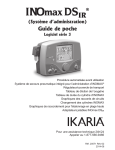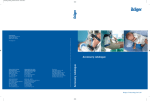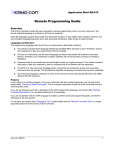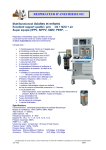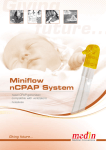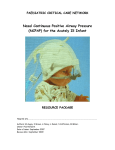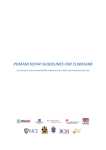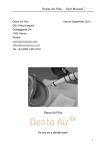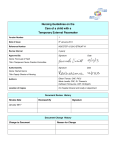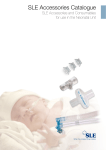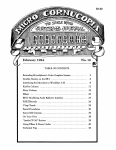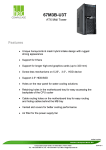Download Quick Set-up Guide - Inspiration Healthcare Home
Transcript
fabian +nCPAP evolution Quick guide TO THE OPERATOR AND PERSON IN CHARGE OF MAINTENANCE AND CARE OF THE UNIT: ●● This Quick Guide is not a substitute for the Operation Manual. Read the Operation Manual carefully before operating the unit. ●● This Quick Guide explains only some of the operations of the fabian +nCPAP evolution ventilator. For details about content not included in this Quick Guide refer to the User Manual. Quick guide for fabian +nCPAP evolution 01-04-2014 1 Quick guide for fabian +nCPAP evolution ventilator Preparations of the ventilator: Connections: (Power cord, gas supply) • Connect power cord to respective power source • Connect medical gas hoses to the respective connections • Connect power cord of humidifier to respective power source Exhalation valve and patient breathing circuit assembly: • Install the exhalation valve membrane holder. Check proper insertion of the membrane. The marking TOP should be visible. Connect inspiratory and expiratory hoses to the respective connections of the ventilator. Make sure that inspiratory and expiratory hose are not connected the wrong way around and that proximal pressure line is correctly installed. Quick guide for fabian +nCPAP evolution-01-04-2014 2 Turn ventilator on: The START SCREEN appears when you turn on the fabian. The device SELF TEST is carried out. All acoustic alarms are suppressed automatically for two minutes. Calibrate flow sensor: Occlude one or both ends of the sensor with a sterile glove and press Flow Cal button Quick guide for fabian +nCPAP evolution-01-04-2014 3 Ventilation Parameter setting: • Select desired ventilation mode first Important: Pushing the mode button displays the available ventilation modes. CONTROL: IPPV TRIGGER: SIPPV, SIMV, SIMV+PSV, PSV CPAP: CPAP nCPAP: nCPAP, duoPAP, O2 Therapy nCPAP* *If NIV and O2 Therapy options are installed Important notice: The option nCPAP is for flow generator systems, so called single limb systems. This system has an automatic leak compensation of max. 25% of the initial flow. In the setup menu, the correct flow generator can be selected. At present time, the following systems are approved by ACUTRONIC: Inspire Infant Flow LP Infant Flow MediJet All dual limb systems are used with the standard CPAP function, which has a flow compensation of 100% of the initial flow. Those systems are for instance F&P FlexiTrunk™, Stephan EasyFlow, Dräger BabyFlow®. Quick guide for fabian +nCPAP evolution-01-04-2014 4 Controls: alarm limits alarm silence manual breath contrast, scaling oxygen flush alpha dial (Click–Turn–Confirm) calibration menu waves/loops on/off stand-by home ventilation modes Turn ventilator off: To turn off the ventilator, the on/off button needs to be pushed for about 5 seconds, until all the blue dots in the status line are gone. If the button is released after the green dots are gone, the unit will be in stand-by mode (vent stand-by 2 minutes). Quick guide for fabian +nCPAP evolution-01-04-2014 5 Ventilation modes Description of the ventilation modes on fabian +nCPAP evolution ventilator: Available modes are: IPPV (CMV) SIPPV (ASSIST) SIMV SIMV+PSV PSV CPAP nCPAP duoPAP O2 Therapy VG VL Intermittent Positive Pressure Ventilation Synchronised Intermittent Positive Pressure Ventilation (Assist Controlled Ventilation) Synchronised Intermittent Mandatory Ventilation Synchronised Intermittent Mandatory Ventilation with Pressure Support Ventilation Pressure Support Ventilation Continuous Positive Airway Pressure Nasal CPAP with Flow Generators Two Level Nasal CPAP with Flow Generators High or Low Flow Oxygen Therapy (with nasal cannula) Volume Guaranteed Ventilation Volume Limited Ventilation IMPORTANT: Volume Guarantee function is available in the following modes: IPPV, SIPPV (ASSIST), SIMV, SIMV+PSV and PSV In the SIMV modes, the Volume Guarantee function is only valid for the SIMV breath and not for the PSV breath. In PSV mode, the VG function is active for the PSV breath as well as for the back up breath in case of APNEA. The backup ventilation will start after the set apnea time. If apnea alarm is set to OFF, the backup ventilation starts right after one period of expiratory time (Te). Quick guide for fabian +nCPAP evolution-01-04-2014 6 Alarm screen, alarm limit setting To access the alarm limits screen, push the alarm limits button. To adjust alarm limits, move cursor to the parameter, push rotary knob and adjust value according to your clinical guidelines. Note ! In PSV mode, the apnea delay time determines after what delay the backup ventilation will start. To allow the baby to breathe with short periods of apnea, the apnea time should be set somewhere in between 3 seconds and 6 seconds. Autoset MV Ppeak PEEP Frequency Leak Apnea Sets the alarm limit automatically based on measured value upper limit 80% above measured value, lower limit 50% below measured value 3 cmH2O above measured value 3 cmH2O below measured value 50% above measured value 10% above measured value 10 seconds Alarm loudness can be set to 3 different levels. Show Log opens the alarm history logfile. Quick guide for fabian +nCPAP evolution-01-04-2014 7 IPPV (CMV) In IPPV, there is no synchronisation with patients breathing pattern. This mode should only be used for patients without spontaneous breathing efforts, sedated patients for instance. Settings to start with: I-Flow between 5 LPM - 8 LPM E-Flow same as I-Flow Rate between 55 and 60 bpm Inspiratory time Ti between 0.3 sec and 0.4 sec Pinsp between 15 – 18 cmH2O PEEP 4 - 6 cmH2O To adjust pressure wave form, use I-Flow. For square pressure waveform increase I-Flow, for accelerating or sine wave, decrease I-Flow. Recommended alarm settings: • Low minute volume • Low PEEP • Ppeak Quick guide for fabian +nCPAP evolution-01-04-2014 8 SIPPV (ASSIST) Every inspiratory effort triggers a breath with a fixed inspiratory time and inspiratory pressure. The minimum rate per minute is the preset one. A patient triggered breath is coloured green, a non-triggered mandatory stroke is grey. Note: It is important that the Ti is watched carefully in this mode – too long a set Ti in an infant with tachypnoea will result in a short expiratory time (Te) and leads to air trapping, with the risk of air leak. Settings to start with: I-Flow 8 LPM E-Flow same as I-Flow Rate 40 bpm Inspiratory time between 0.3 sec and 0.4 sec Pinsp between 16 – 18 cmH2O PEEP 4 – 6 cmH2O Recommended alarms: Same as IPPV but in addition Respiratory Rate to alert in case of Hyperventilation Try to achieve an exhaled tidal volume of about 5 – 6 ml/kg bodyweight. To increase Tidal Volume, increase Pinsp and eventually raise PEEP. Remark: A grey coloured breath is a mechanical non-triggered breath whereas a green coloured is a patient triggered one. Quick guide for fabian +nCPAP evolution-01-04-2014 9 SIMV The ventilator synchronizes patients inspiratory efforts and delivers a fixed amount of synchronised mechanical breath with preset inspiratory time. Spontaneous inspiratory efforts in between mechanical breath are on PEEP level. Settings to start with: I-Flow 8 LPM E-Flow same as I-Flow Rate between 20 to 30 bpm Inspiratory time between 0.3 sec and 0.4 sec Pinsp between 16 – 18 cmH2O PEEP 4 - 6 cmH2O Remark: A grey coloured breath is a mechanical non-triggered breath whereas a green coloured breath is a patient triggered one. If VG option is available, it can be added to SIMV. Quick guide for fabian +nCPAP evolution-01-04-2014 10 SIMV+PSV The ventilator synchronizes the patients inspiratory effort and delivers a breath at fixed pressure levels but variable I-Time is controlled by the patient based on preset flow termination criteria. The rate is controlled by the patient. Settings to start with: I-Flow 8 LPM E-Flow same as I-Flow Rate between 20 to 40 bpm Inspiratory time between 0.3 sec and 0.4 sec Pinsp between 16 – 18 cmH2O PPSV 16 – 18 cmH2O PEEP 4 - 6 cmH2O Important: In SIMV-PSV mode the I-Time button has changed colour (to orange) because it is also the maximal time limit in PSV. The minimum pressure difference between PEEP and PPSV is 2 cmH2O and PPSV is max same level as Pinsp. Quick guide for fabian +nCPAP evolution-01-04-2014 11 PSV The ventilator synchronizes the patient‘s inspiratory effort and delivers a breath at fixed pressure levels but variable I-Time, which is controlled by the patient based on preset flow termination criteria. The rate is controlled by the patient. Settings to start with: I-Flow 8 LPM E-Flow same as I-Flow Rate between 30 to 40 bpm Inspiratory time between 0.3 sec and 0.4 sec Pinsp between 16 – 18 cmH2O PPSV 16 – 18 cmH2O PEEP 4 - 6 cmH2O Important: In PSV mode, the apnea backup ventilation will start after the preset apnea delay (set in the alarm menu). Make sure to set this apnea delay to about 4 – 6 seconds, because babies tend to have short periods of apnea and you don‘t want the ventilator to kick in too early. If apnea is set to OFF, the ventilator starts backup after E-Time. In PSV, the I-Time button has changed to orange because it is the maximal time limit in PSV. The minimum pressure difference between PEEP and PPSV is always 2 cmH2O and PPSV is max same level as Pinsp. Quick guide for fabian +nCPAP evolution-01-04-2014 12 CPAP The CPAP mode can be used for intubated patients as well as for nasal CPAP. If used with nasal CPAP systems like F&P bubble CPAP, Hudson or similar, the Flow sensor must be deactivated manually in the calibration screen. The ventilator automatically compensates leaks by increasing flow to max Flowmin plus 100% to avoid CPAP pressure drop. Settings to start with: FLOW min CPAP Pmanual Backup 8 LPM 5 cmH2O 19 cmH2O OFF Important: Make sure the Flow sensor is deactivated, otherwise the apnea alarm is triggered at all times. Use alternative system for apnea detection. For Variable Flow systems like Infant Flow®, Inspire™ or MediJet®, please use the option NCPAP and DUOPAP if available in your unit. Quick guide for fabian +nCPAP evolution-01-04-2014 13 nCPAP The nCPAP mode is used for flow generator systems like Inspire, Infant Flow, MediJet or similar ones with a single limb. This single limb systems generate a backpressure in the inspiratory limb, which is higher than during conventional ventilation and therefore needs a higher over pressure relieve valve setting. On the fabian, the inner outlet is designed for this purpose and requires a different connection limb between ventilator and humidifier chamber. Based on the preset pressure level, the flow is adjusted automatically Proper connection is as below: Quick guide for fabian +nCPAP evolution-01-04-2014 14 duoPAP duoPAP is like a bi-level CPAP system. The settings to start with: CPAP: PDUO: I-time: Frequency: 5 cmH2O 8 cmH2O 0.7 sec 30 bpm Depending on blood gas, an elevated PaCO2 can be reduced by increasing PDUO. Oxygenation is improved by increasing CPAP level Proper connection is as below: Quick guide for fabian +nCPAP evolution01-11-2013 15 O2 Therapy O2 Therapy is an option which allows use of a continous flow of blended gas, from 1 – 15 LPM. Nasal cannulas of various makes like F&P, Atom or similar can be used. There are no alarm functions active in this mode, except for the set FiO2 For weaning purposes, this mode can also be used in conjunction with variable flow systems like Infant Flow®, Inspire™ or MediJet®, however there won‘t be any alarm settings on pressure monitoring. Note: This mode can also be used to put the ventilator in standby mode. By setting a flow of 4 LPM, the humidifier dual servo temperature controls remain active, so no need to switch it off in case of short term standby mode. Also, the O2 Therapy mode requires the special connection between ventilator and humidifier due to resistance by the nasal cannula at higher flows Quick guide for fabian +nCPAP evolution-01-04-2014 16 Features Grafics: Waves: Displays 3 waveforms, Pressure, Flow and Volume simultaneously Freeze: Freezes the Waves or Loops Loops: Pressure-Volume and Flow-Volume Loops Trends: up to 5 days trending of measured values Save Loop: The save Loop function stores one Loop and keep it as reference until a new Loop is saved Waves: Reference Loops: Loops: Quick guide for fabian +nCPAP evolution-01-04-2014 17



















